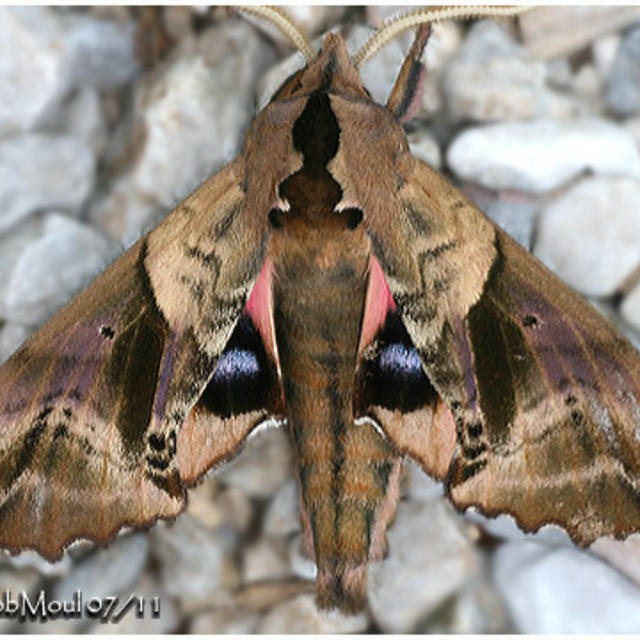Blinded sphinx
Paonias excaecata (J.E. Smith, 1797)
Family: Sphingidae
Subfamily: Sphinginae
Identification: Outer margins of the forewings are strongly scalloped, with white fringe on the concave part of the scallops. Forewing upperside is pale gray to dark reddish brown; underside has pink at the base. Upperside of hindwing is pale to dark brown with a broad pink patch at the base and a single blue eyespot.
Wing Span: 2 3/16 - 3 3/4 inches (5.5 - 9.5 cm).
Life History: Eggs hatch seven to eight days after they are laid. Fully-grown caterpillars pupate and overwinter in underground chambers.
Flight: . Three broods in Florida from March-October, several broods in Louisiana from March-September, and one or two broods in the rest of the range from May-September.
Caterpillar Hosts: A variety of deciduous trees including basswood (Tilia), willow (Salix), birch (Betula), hawthorn (Crataegus), poplar (Populus), oaks (Quercus), ocean spray (Holodiscus), and cherry (Prunus).
Adult Food: Adults do not feed.
Habitat: Deciduous woods, other wooded habitats, and suburbs.
Range: Throughout most of the United States and southern Canada from Nova Scotia and Maine south to Florida; west to British Columbia and Washington, northern California, and Arizona.
Conservation: Not usually required.
NCGR: G5 - Demonstrably secure globally, though it may be quite rare in parts of its range, especially at the periphery.
Management Needs: None reported.
Alternate Scientific Names:
Paonias excaecatus
Get your BAMONA Gear!
Please donate!
We depend on donations to keep Butterflies and Moths of North America freely available. We want to express our gratitude to all who showed their support by making a contribution this year. You can donate to support this project at any time.
Advertise with us!
Do you have a product or service that you think would interest BAMONA users? If you would like to advertise on this website, contact us by email, or use the contact form and select the "Advertising" category.
Verified Sightings
Displaying 145 - 168 of 1315 verified sightings

Observation date: May 30, 2021
Submitted by: Lppaille
Region: Quebec, Canada
Verified by: Sue Gregoire
Verified date: Jun 03, 2021

Observation date: May 28, 2021
Submitted by: rebecca husted
Region: Jones County, Georgia, United States
Verified by: Mikelchap
Verified date: May 29, 2021

Observation date: May 22, 2021
Submitted by: kylie.grout
Region: Georgia, United States
Verified by: Mikelchap
Verified date: May 22, 2021

Observation date: Jul 30, 2019
Submitted by: Bea Kohlhaas
Region: New Brunswick, Canada
Verified by: Sue Gregoire
Verified date: Mar 20, 2021

Observation date: Jul 05, 2018
Submitted by: Roberto Egiziano
Region: Quebec, Canada
Verified by: Sue Gregoire
Verified date: Mar 18, 2021

Observation date: Jul 19, 2017
Submitted by: Patrick Narbonne
Region: Quebec, Canada
Verified by: Sue Gregoire
Verified date: Mar 17, 2021

Observation date: Jun 22, 2016
Submitted by: Slaszlo
Region: Quebec, Canada
Verified by: Sue Gregoire
Verified date: Mar 16, 2021

Observation date: May 27, 2018
Submitted by: TammyC
Region: Linn County, Oregon, United States
Verified by: J_Martineau
Verified date: Mar 14, 2021

Observation date: Jul 06, 2016
Submitted by: Scotiaspinner
Region: New Brunswick, Canada
Verified by: Sue Gregoire
Verified date: Mar 14, 2021

Observation date: Jul 09, 2018
Submitted by: Whit Brown
Region: Georgia, Towns County, United States
Verified by: Mikelchap
Verified date: Mar 11, 2021

Observation date: Jul 09, 2018
Submitted by: gnarnia
Region: Oxford County, Maine, United States
Verified by: Sue Gregoire
Verified date: Mar 06, 2021

Observation date: Jul 19, 2020
Submitted by: Misadvencherus
Region: Multnomah County, Oregon, United States
Verified by: J_Martineau
Verified date: Feb 24, 2021

Observation date: Jul 25, 2019
Submitted by: Rspin74
Region: Cumberland County, Maine, United States
Verified by: Sue Gregoire
Verified date: Feb 21, 2021

Observation date: Jul 02, 2020
Submitted by: leahterp
Region: Cumberland County, Maine, United States
Verified by: Sue Gregoire
Verified date: Feb 16, 2021

Observation date: Jul 17, 2020
Submitted by: kathybrown
Region: Knox County, Maine, United States
Verified by: Sue Gregoire
Verified date: Feb 15, 2021

Observation date: Jul 20, 2020
Submitted by: SarahP
Region: Hancock County, Maine, United States
Verified by: Sue Gregoire
Verified date: Feb 15, 2021

Observation date: Jul 08, 2013
Submitted by: billmaciejko
Region: Manitoba, Canada
Verified by: chalicerae
Verified date: Feb 14, 2021

Observation date: Jul 06, 2018
Submitted by: jbrown81
Region: Lamoille County, Vermont, United States
Verified by: jwileyrains
Verified date: Feb 04, 2021

Observation date: Jun 19, 2019
Submitted by: Moorel15
Region: Midland County, Michigan, United States
Verified by: Mark Wheeler
Verified date: Feb 03, 2021

Observation date: Jul 05, 2019
Submitted by: ravenwcatz
Region: Iosco County, Michigan, United States
Verified by: Mark Wheeler
Verified date: Feb 03, 2021

Observation date: Jul 23, 2019
Submitted by: Sommerfield89
Region: Grand Traverse County, Michigan, United States
Verified by: Mark Wheeler
Verified date: Feb 02, 2021

Observation date: Jul 04, 2020
Submitted by: Sparky79B3
Region: St. Clair County, Michigan, United States
Verified by: Mark Wheeler
Verified date: Feb 01, 2021

Observation date: Jul 06, 2019
Submitted by: tabbyhusky
Region: Luce County, Michigan, United States
Verified by: Mark Wheeler
Verified date: Feb 01, 2021

Observation date: Jul 18, 2020
Submitted by: John Daugherty
Region: Benzie County, Michigan, United States
Verified by: Mark Wheeler
Verified date: Feb 01, 2021
- ‹ previous
- 7 of 55
- next ›

















